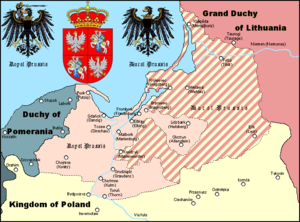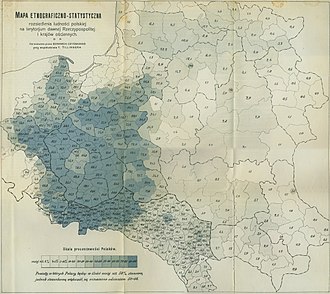Hành lang Ba Lan




Hành lang Ba Lan ( tiếng Đức: Polnischer Korridor; tiếng Ba Lan: Pomorze, Polski Korytarz), cũng gọi là hành lang Danzig, Hành lang ra biển hoặc hành lang Gdańsk, là một lãnh thổ tọa lạc ở vùng Pomerelia (tỉnh Pomerania, đông Pomerania, trước đó thuộc Tây Phổ), cung cấp cho Đệ nhị Cộng hòa Ba Lan (1920–1939) lối ra biển Baltic, do đó chia phần lớn Đức (Cộng hòa Weimar) khỏi tỉnh Đông Phổ. Thành phố tự do Danzig (nay là thành phố Gdańsk của Ba Lan) tách biệt với cả Ba Lan và Đức. Một lãnh thổ tương tự, đôi khi cũng được gọi là hành lang, đã được kết nối với Triều đình Ba Lan như một phần của Hoàng gia Phổ trong thời kỳ 1466–1772.[1][2]
Thuật ngữ
[sửa | sửa mã nguồn]Theo nhà sử học người Đức Hartmut Boockmann, thuật ngữ "Hành lang" lần đầu tiên được sử dụng bởi các chính trị gia Ba Lan,[3] trong khi nhà sử học Ba Lan Grzegorz Lukomski viết rằng từ này được đặt ra bởi sự tuyên truyền của chủ nghĩa dân tộc Đức trong thập niên 1920.[4] Trên phạm vi quốc tế, thuật ngữ này đã được sử dụng bằng tiếng Anh ngay từ tháng 3 năm 1919[5] và bất kể nguồn gốc của nó, nó đã trở thành một thuật ngữ phổ biến trong việc sử dụng tiếng Anh.[6][7][8][9][10][11][12]
Tham khảo
[sửa | sửa mã nguồn]- ^ A History of Western Civilization: Then came the acquisition of Prussia (separated from Brandenburg by the "Polish corridor") page 382, author Roland N. Stromberg Dorsey Press 1969.
- ^ The Scandinavians in History. "Brandenburg, bằng việc mua lại Đông Pomerania bên cạnh các lãnh thổ khác trong đế chế đã được thiết lập vững chắc trên Baltic, mặc dù một hành lang Ba Lan chạy giữa Đông Pomerania và Đông Phổ đến Danzig đã phủ nhận tất cả những gì bà mong muốn", trang 174, tác giả Stanley Mease Toyne.
- ^ Hartmut Boockmann, Ostpreussen und Westpreussen, Siedler 2002, p. 401, ISBN 3-88680-212-4 [1]
- ^ Grzegorz Lukomski, The problem of Corridor in the Polish-German relationships and on the international stage 1918 - 1939. A political study Lưu trữ ngày 24 tháng 2 năm 2012 tại Wayback Machine (in Polish)
- ^ The New York Times: ngày 18 tháng 3 năm 1919: POLISH "CORRIDOR."; Paris Paper Sketches Proposed Strip to Danzig.; ngày 17 tháng 3 năm 1919: Plan to Give Germany Land Communication Across Polish Corridor to the Baltic
- ^ Edmund Jan Osmańczyk, Anthony Mango, Encyclopedia of the United Nations and international agreements, 3rd edition, Taylor & Francis, 2003, p.1818, ISBN 0-415-93921-6: "Polish Corridor: International term for Poland's access to the Baltic in 1919-1939."
- ^ Hartmut Boockmann, Ostpreussen und Westpreussen, Siedler 2002, p. 401,ISBN 3-88680-212-4 [2]
- ^ e.g.The New York Times: ngày 18 tháng 3 năm 1919: POLISH "CORRIDOR."; Paris Paper Sketches Proposed Strip to Danzig.; ngày 16 tháng 8 năm 1920: Russians Hoist the German Flag Over Soldau; Say Polish Corridor Will Be Returned to Germany; ngày 17 tháng 3 năm 1919: Plan to Give Germany Land Communication Across Polish Corridor to the Baltic; ngày 16 tháng 11 năm 1930 EUROPE SOREST SPOT: THE POLISH CORRIDOR.; THE OLD GERMAN PORT OF DANZIG; ngày 17 tháng 8 năm 1932 GERMANS UNITED ON POLISH CORRIDOR
- ^ Denmark: Salmonsens Konversationsleksikon, e.g., in the article about railways: ("the German railway network was reduced due to [Germany's] territorial concessions following the [first world] war and is cut in two separate parts by the Polish corridor.")[3] (1930) and article about Poland [4] (1924)
- ^ New York Times early 1919
- ^ “Time magazine, 1925”. Bản gốc lưu trữ ngày 9 tháng 2 năm 2009. Truy cập ngày 18 tháng 5 năm 2021.
- ^ Barbara Dotts Paul, The Polish-German Borderlands: An Annotated Bibliography, Greenwood Publishing Group, 1994, ISBN 0-313-29162-4: contains an abundant collection of contemporary sources using Polish or Danzig Corridor
 GIẢM
41%
GIẢM
41%
 GIẢM
31%
GIẢM
31%
![[Sách] Những cô em gái - Nguyễn Nhật Ánh](https://down-ws-vn.img.susercontent.com/15910be8b1f00f27ed5c124482bcbcfd.webp) GIẢM
13%
GIẢM
13%
 GIẢM
39%
GIẢM
39%
 GIẢM
17%
GIẢM
17%
 GIẢM
30%
GIẢM
30%



